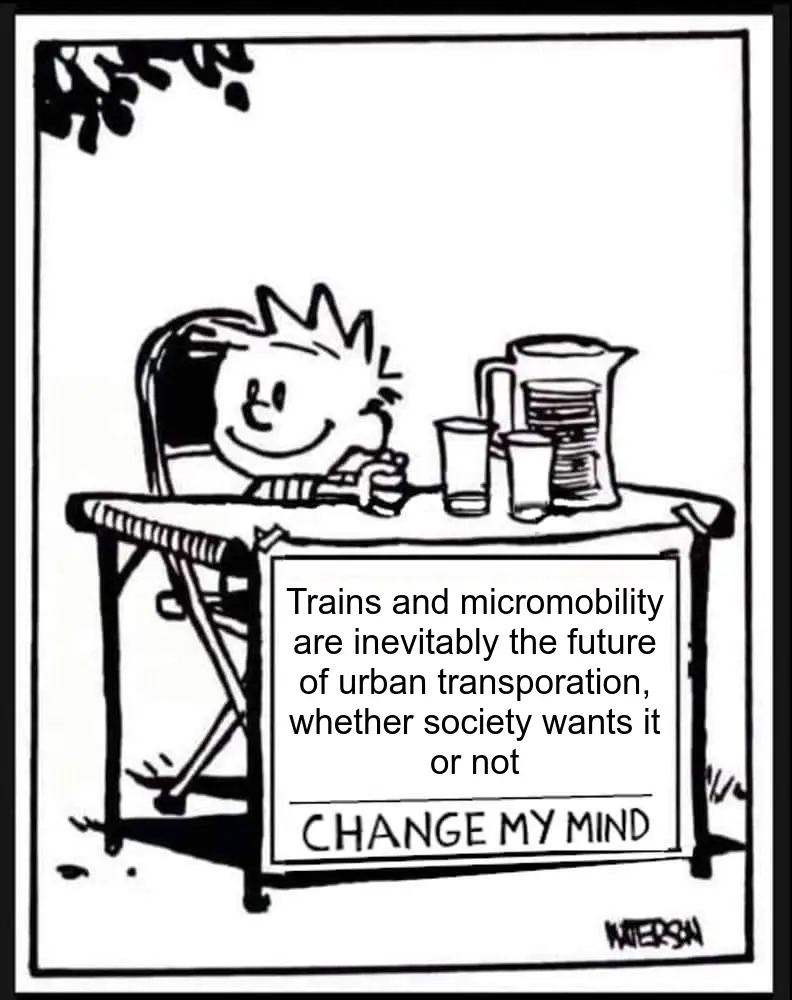view the rest of the comments
Fuck Cars
A place to discuss problems of car centric infrastructure or how it hurts us all. Let's explore the bad world of Cars!
Rules
1. Be Civil
You may not agree on ideas, but please do not be needlessly rude or insulting to other people in this community.
2. No hate speech
Don't discriminate or disparage people on the basis of sex, gender, race, ethnicity, nationality, religion, or sexuality.
3. Don't harass people
Don't follow people you disagree with into multiple threads or into PMs to insult, disparage, or otherwise attack them. And certainly don't doxx any non-public figures.
4. Stay on topic
This community is about cars, their externalities in society, car-dependency, and solutions to these.
5. No reposts
Do not repost content that has already been posted in this community.
Moderator discretion will be used to judge reports with regard to the above rules.
Posting Guidelines
In the absence of a flair system on lemmy yet, let’s try to make it easier to scan through posts by type in here by using tags:
- [meta] for discussions/suggestions about this community itself
- [article] for news articles
- [blog] for any blog-style content
- [video] for video resources
- [academic] for academic studies and sources
- [discussion] for text post questions, rants, and/or discussions
- [meme] for memes
- [image] for any non-meme images
- [misc] for anything that doesn’t fall cleanly into any of the other categories

The US (and much of europe) needs to realize that car centric planning is not the solution to mobility problems, it's the cause! Suburbia could be more walkable if a few steps were taken during planning:
narrower roads (less wasted space, slower driving speeds, shorter distances)
Pedestrian paths that connect cul-de-sacs and streets (quicker access to higher order roads for pedestrians)
mixed use zoning/town houses (bring destinations to the people)
no mandatory minimum parking requirements for businesses (same advantages as my first point)
Note that the commenter said rural rather than suburban, and that's a really whole other can of worms, but on the other hand they aren't as frustrating to have cars. The population density is so low and the distances so large, it's hard to figure any thing other than cars to meet those needs.
But I'm in suburbia, in fact right next to one of my cities mixed use mandate (all new housing must be dense housing and must construct retail space and office space with any housing construction). They also have very little parking for the retail space. So what has happened with those projects? The housing has filled up, but no company wants the retail space. A company could choose to open up a store there to serve that community and not much else owing to tiny parking, or they can set up 5 miles away for not much more and serve dozens of communities.
There was one successful mixed use development, but they were massive and dedicated a huge amount to multiple parking decks. People pay a lot of money to live there and it is walkable distance wise, but it's car centric and unfortunately would have failed without accommodating cars.
Best walkable experience I've had was a place with trams and pedestrian bridges, as well as roads and parking decks. Businesses could count on the reach afforded by accommodating cars, and pedestrians never had to step on a car road or suffer a bus stuck in traffic. However, it was a massively expensive place to be.